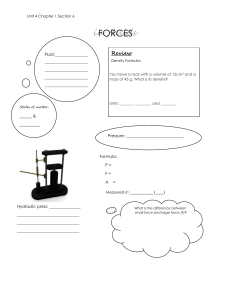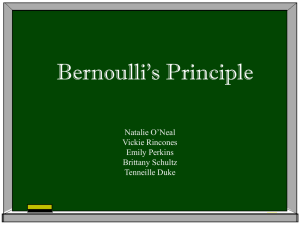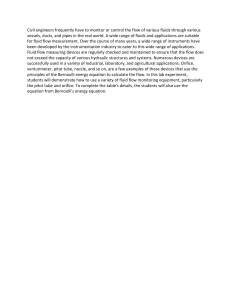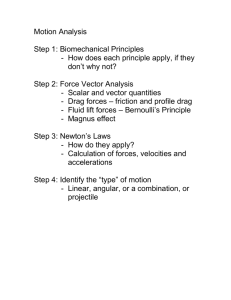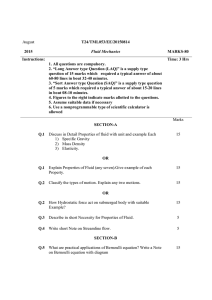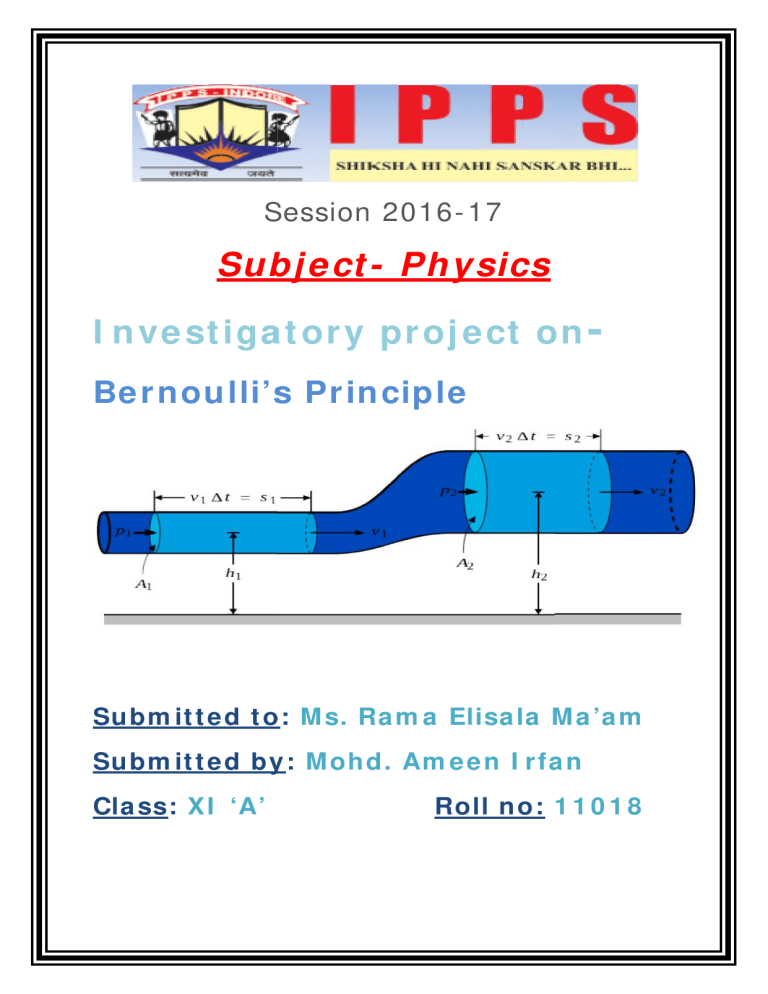
Ses Session 2016- 17 Su u bj e ct - Ph ysics cs I n ve st iga ga t or y pr oj e ct on Be r n ou lli’s i’s Pr inciple Su bm it t e d t o: M s. Ra m a Elisa la M a ’a m Su bm it t e d by by: M ohd. Am e e n I r fa n Cla ss: XI ‘A’’ Roll n o:: 1 1 0 1 8 CERTIFICATE This is to certify that Mohd. Ameen Irfan of class 11th ‘A’ has completed the project work in physics in the year 2016-17 on “Bernoulli’s Theorem” under the guidance of Ms. Rama Elisala Ma’am as prescribed by CBSE course. It is further certified that this project is the individual work of the student. Internal Examiner Principal’s Signature School Stamp Acknowledgement I would like to express my special thanks of gratitude to my subject teacher Ms. Rama Elisala Ma’am to give her guidance to make the successful completion of this project. I also want to give special thanks to our principal ma’am Ms. Priya Chouhan Ma’am who gave me this golden opportunity to do this wonderful project on the topic “Bernoulli’s Theorem”, so that I will get to know about detailed information for the same. Secondly I would like to thank my parents and classmates who helped me to complete this project within the given time frame. Content • Pressure • Pascal’s Law • Hydraulics • Continuity Equation • Bernoulli’s Equation • Derivation of Bernoulli’s Equation • Venturi Tube • Atomizer • Torricelli and his Orifice • Derivation of Torricelli’s Equation • Streamlines • Aerodynamic Lift • Misconceptions of Lift • Conclusion • Bibliography PRESSURE 1. Pressure is defined as force per unit area. 2. Standard unit is Pascal, which is N/m2 3. For liquid pressure, the medium is considered as a continuous distribution of matter. 4. For gas pressure, it is calculated as the average pressure of molecular collisions on the container. 5. Pressure acts perpendicular on the surface. 6. Pressure is a scalar quantity – pressure has no particular direction (i.e. acts in every direction). Pascal’s Law Pf = P0 + ρgh 1. “When there is an increase in pressure at any point in a confined fluid, there is an equal increase at every point in the container.” 2. In a fluid, all points at the same depth must be at the same pressure. 3. Consider a fluid in equilibrium. Hydraulics You have to push down the piston on the left far down to achieve some change in the height of the piston on the right. 1. Pressure is equal at the bottom of both containers (because it’s the same depth!) 2. P = F2/A2 = F1/A1 and since A1 < A2, F2 > F1 3. There is a magnification of force, just like a lever, but work stays the same! (Conservation of energy). W = F1* D1 = F2 * D2 ∴ D1 > D2 Continuity Equation 1. A1v1 = A2v2 2. “What comes in comes out.” 3. Av= V/s (volume flow rate) = constant Bernoulli’s Equation P+1/2ρv*v+ρgh=constant Where p is the pressure, ρ is the density, v is the velocity, h is elevation, and g is gravitational acceleration Derivation of Bernoulli’s Equation Restrictions Incompressible Non-viscous fluid (i.e. no friction) Following a streamline motion (no turbulence) Constant density *There exists an extended form of equation that takes friction and compressibility into account, but that is too complicated for our level of study. Et ot al = 1 / 2 m v 2 + m gh W = F/ A* A* d = PV • Consider the change in total energy of the fluid as it moves from the inlet to the outlet. Δ Etotal = Wdone on fluid - Wdone by fluid Δ Etotal = (1/2mv22 + mgh1) – (1/2mv12 + mgh2) Wdone on fluid - Wdone by fluid = (1/2mv22 + mgh1) – (1/2mv12 + mgh2) P2V2 - P1V1 = (1/2mv22 + mgh1) – (1/2mv12 + mgh2) P2 – P1 = (1/2ρ v12 + ρ gh1) – (1/2ρ v12 + ρ gh1) Venturi Tube 1. A2 < A1 ; V2 > V1 2. According to Bernoulli’s Law, pressure at A2 is lower. 3. Choked flow: Because pressure cannot be negative, total flow rate will be limited. This is useful in controlling fluid velocity. P2 + 1 / 2 ρ v 1 2 = P1 + Δ P = ρ/ 2 * ( v 2 2 – v 1 2 ) 1 / 2ρ v 12 ; Atomizer • This is an atomizer, which uses the Venturi effect to spray liquid. • When the air stream from the hose flows over the straw, the resulting low pressure on the top lifts up the fluid. Torricelli and his Orifice • In 1843, Evangelista Torricelli proved that the flow of liquid through an opening is proportional to the square root of the height of the opening. • Q = A*√(2g(h1-h2)) where Q is flow rate, A is area, h is height Depending on the contour and shape of the opening, different discharge coefficients can be applied to the equation (of course we assume simpler situation here- Derivation of Torricelli’s Equation 1. We use the Bernoulli Equation: 2. In the original diagram A1 [top] is much larger than A2 [the opening]. Since A1V1 = A2V2 and A1 >> A2, V1 ≈ 0 3. Since both the top and the opening are open to atmospheric pressure, P1 = P2 = 0 (in gauge pressure). The equation simplifies down to: ρgh1 = 1/2 ρv22 + ρgh2 /2 ρv22 = pg(h1-h2) 1 V22 = 2g(h1-h2) ∴ V2 = √(2g(h1-h2)) Q = Av2 = A √(2g(h1-h2)) Streamlines 1 A streamline is a path traced out by a mass less particle as it moves with the flow. 2. Velocity is zero at the surface. 1. As you move away from the surface, the velocity uniformly approaches the free stream value (fluid molecules nearby the surface are dragged due to viscosity). 2. The layer at which the velocity reaches the free stream value is called boundary layer. It does not necessarily match the shape of the object – boundary layer can be detached, creating turbulence (wing stall in aerodynamic terms). Aerodynamic Lift 1. Lift is the fort that keeps an aircraft in the air. 2. In Bernoulli-an view, lift is produced by the different of pressure (faster velocity on the top, slower velocity in the bottom) 3. In Newtonian view, lift is the reaction force that results from the downward deflection of the air. 3. 4. Both views are correct, but the current argument arises from the misapplication of either view. The most accurate explanation would take into account the simultaneous conservation of mass, momentum, and energy of a fluid, but that involves multivariable calculus. Misconceptions of Lift 1. In many popular literature, encyclopedia, and even textbooks, Bernoulli’s Law is used incorrectly to explain the aerodynamic lift. #1: Equal transit time - The air on the upper side of the wing travels faster because it has to travel a longer path and must “catch up” with the air on the lower side. The error lies in the specification of velocity. Air is not forced to “catch up” with the downside air. Also, this theory predicts slower velocity than in reality. Conclusion Bernoulli's law states that if a non-viscous fluid is flowing along a pipe of varying cross section, then the pressure is lower at constrictions where the velocity is higher, and the pressure is higher where the pipe opens out and the fluid stagnate. Many people find this situation paradoxical when they first encounter it (higher velocity, lower pressure). Venturi-meter, atomizer and filter pump Bernoulli’s principle is used in venturi-meter to find the rate of flow of a liquid. It is used in a carburetor to mix air and petrol vapor in an internal combustion engine. Bernoulli’s principle is used in an atomizer and filter pump. Wings of Aero plane Wings of an aero plane are made tapering. The upper surface is made convex and the lower surface is made concave. Due to this shape of the wing, the air currents at the top have a large velocity than at the bottom. Consequently the pressure above the surface of the wing is less as compared to the lower surface of the wing. This difference of pressure is helpful in giving a vertical lift to the plane. BIBLIOGRAPHY 1. Help from Internet • www.sceincefare.com • www.mycbsegide.com • www.slideshare.com 2. Help from books • Referenced from H.C. Verma • Referenced from physics NCERT 3. Help from teachers • Rama Elisala Ma’am
